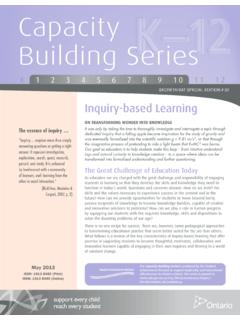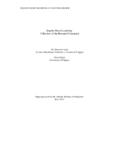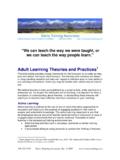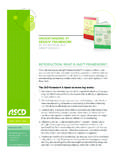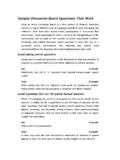Transcription of Why Minimal Guidance During Instruction Does Not …
1 EDUCATIONAL PSYCHOLOGIST, 41(2), 75 86. Copyright 2006, Lawrence Erlbaum Associates, Inc. KIRSCHNER, Minimal Guidance . SWELLER, CLARK. Why Minimal Guidance During Instruction Does Not Work: An Analysis of the Failure of Constructivist, Discovery, problem - based , Experiential, and Inquiry- based Teaching Paul A. Kirschner Educational Technology Expertise Center Open University of the Netherlands Research Centre Learning in Interaction Utrecht University, The Netherlands John Sweller School of Education University of New South Wales Richard E. Clark Rossier School of Education University of Southern California Evidence for the superiority of guided Instruction is explained in the context of our knowledge of human cognitive architecture, expert novice differences, and cognitive load.
2 Although un- guided or minimally guided instructional approaches are very popular and intuitively appeal- ing, the point is made that these approaches ignore both the structures that constitute human cognitive architecture and evidence from empirical studies over the past half-century that con- sistently indicate that minimally guided Instruction is less effective and less efficient than in- structional approaches that place a strong emphasis on Guidance of the student learning pro- cess. The advantage of Guidance begins to recede only when learners have sufficiently high prior knowledge to provide internal Guidance . Recent developments in instructional research and instructional design models that support Guidance During Instruction are briefly described.
3 Disputes about the impact of instructional Guidance During cedures by themselves ( , Cronbach & Snow, 1977; Klahr teaching have been ongoing for at least the past half-century & Nigam, 2004; Mayer, 2004; Shulman & Keisler, 1966;. (Ausubel, 1964; Craig, 1956; Mayer, 2004; Shulman & Sweller, 2003). Direct instructional Guidance is defined as Keisler, 1966). On one side of this argument are those advo- providing information that fully explains the concepts and cating the hypothesis that people learn best in an unguided or procedures that students are required to learn as well as learn- minimally guided environment, generally defined as one in ing strategy support that is compatible with human cognitive which learners, rather than being presented with essential in- architecture.
4 Learning, in turn, is defined as a change in formation, must discover or construct essential information long-term memory. for themselves ( , Bruner, 1961; Papert, 1980; Steffe & The minimally guided approach has been called by vari- Gale, 1995). On the other side are those suggesting that nov- ous names including discovery learning (Anthony, 1973;. ice learners should be provided with direct instructional Bruner, 1961); problem - based learning (PBL; Barrows &. Guidance on the concepts and procedures required by a par- Tamblyn, 1980; Schmidt, 1983), inquiry learning (Papert, ticular discipline and should not be left to discover those pro- 1980; Rutherford, 1964), experiential learning (Boud, Keogh, & Walker, 1985; Kolb & Fry, 1975), and Correspondence should be addressed to Paul A.
5 Kirschner, Research Cen- constructivist learning (Jonassen, 1991; Steffe & Gale, tre Learning in Interaction, Utrecht University, The Netherlands, Box 1995). Examples of applications of these differently named 80140, 3508 TC, Utrecht, The Netherlands. E-mail: but essentially pedagogically equivalent approaches include 76 KIRSCHNER, SWELLER, CLARK. science Instruction in which students are placed in inquiry with no reference to the characteristics of working memory, learning contexts and asked to discover the fundamental and long-term memory, or the intricate relations between them. well-known principles of science by modeling the investiga- The result is a series of recommendations that most educators tory activities of professional researchers (Van Joolingen, de find almost impossible to implement and many experi- Jong, Lazonder, Savelsbergh, & Manlove, 2005).
6 Similarly, enced educators are reluctant to implement because they medical students in problem - based teaching courses are re- require learners to engage in cognitive activities that are quired to discover medical solutions for common patient highly unlikely to result in effective learning. As a conse- problems using problem -solving techniques (Schmidt, 1998, quence, the most effective teachers may either ignore the rec- 2000). ommendations or, at best, pay lip service to them ( , Aulls, There seem to be two main assumptions underlying in- 2002). In this section we discuss some of the characteristics structional programs using Minimal Guidance . First they chal- of human cognitive architecture and the consequent instruc- lenge students to solve authentic problems or acquire com- tional implications.
7 Plex knowledge in information-rich settings based on the assumption that having learners construct their own solutions Human Cognitive Architecture leads to the most effective learning experience. Second, they appear to assume that knowledge can best be acquired through Human cognitive architecture is concerned with the manner in experience based on the procedures of the discipline ( , see- which our cognitive structures are organized. Most modern ing the pedagogic content of the learning experience as identi- treatments of human cognitive architecture use the Atkinson cal to the methods and processes or epistemology of the disci- and Shiffrin (1968) sensory memory working mem- pline being studied; Kirschner, 1992). Minimal Guidance is ory long-term memory model as their base.
8 Sensory memory offered in the form of process- or task-relevant information is not relevant to the discussion here so it is not considered fur- that is available if learners choose to use it. Advocates of this ther. The relations between working and long-term memory, in approach imply that instructional Guidance that provides or conjunction with the cognitive processes that support learn- embeds learning strategies in Instruction interferes with the ing, are of critical importance to the argument. natural processes by which learners draw on their unique prior Our understanding of the role of long-term memory in hu- experience and learning styles to construct new situated man cognition has altered dramatically over the last few de- knowledge that will achieve their goals.
9 According to Wickens cades. It is no longer seen as a passive repository of discrete, (1992, cited in Bernstein, Penner, Clarke-Stewart, Roy, & isolated fragments of information that permit us to repeat Wickens, 2003), for example, what we have learned. Nor is it seen only as a component of human cognitive architecture that has merely peripheral in- large amounts of Guidance may produce very good perfor- fluence on complex cognitive processes such as thinking and mance During practice, but too much Guidance may impair problem solving. Rather, long-term memory is now viewed later performance. Coaching students about correct responses as the central, dominant structure of human cognition. Every- in math, for example, may impair their ability later to retrieve thing we see, hear, and think about is critically dependent on correct responses from memory on their own.
10 (p. 221) and influenced by our long-term memory. De Groot's (1945/1965) work on chess expertise, followed This constructivist argument has attracted a significant fol- by Chase and Simon (1973), has served as a major influence on lowing. the field's reconceptualization of the role of long-term mem- The goal of this article is to suggest that based on our ory. The finding that expert chess players are far better able current knowledge of human cognitive architecture, mini- than novices to reproduce briefly seen board configurations mally guided Instruction is likely to be ineffective. The past taken from real games, but do not differ in reproducing random half-century of empirical research on this issue has pro- board configurations, has been replicated in a variety of other vided overwhelming and unambiguous evidence that mini- areas ( , Egan & Schwartz, 1979; Jeffries, Turner, Polson, &.)

